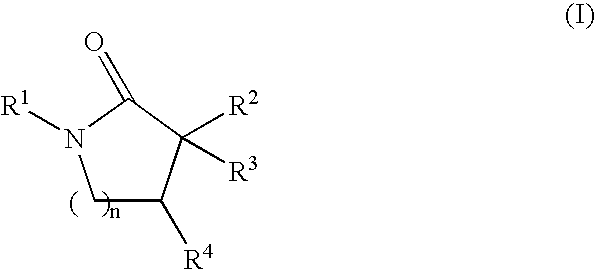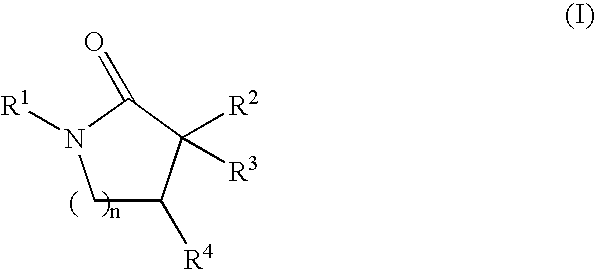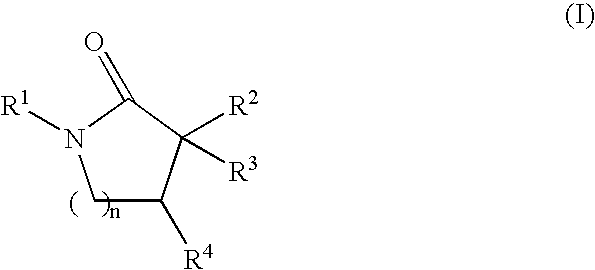Inhibitors of the 11-beta-hydroxysteroid dehydrogenase type 1 enzyme
a technology of hydroxysteroid dehydrogenase and enzyme, which is applied in the field of enzyme inhibitors and inhibitors of the 11-beta-hydroxysteroid dehydrogenase type 1 enzyme, can solve the problems of increased and premature morbidity and mortality, poor compliance, and insufficient compensatory increase to overcome insulin resistan
- Summary
- Abstract
- Description
- Claims
- Application Information
AI Technical Summary
Benefits of technology
Problems solved by technology
Method used
Image
Examples
example 1
6-[(1-cycloheptyl-4,4-dimethyl-5-oxopyrrolidin-3-yl)methoxy]nicotinonitrile
example 1a
1-Cycloheptyl-5-oxo-pyrrolidine-3-carboxylic acid methyl ester
[0142] A solution of dimethyl itaconate (0.5 g, 3.16 mmoles), cycloheptylamine (0.357 g, 3.16 mmoles) in methanol (5 mL) was heated at 85° C. for eighteen hours. The solvent was evaporated in vacuo and the resulting crude product was purified by flash chromatography (hexanes / ethyl acetate 80:20 to 20:80) to give the title compound as a colorless oil.
example 1b
4-(tert-Butyl-dimethyl-silanyloxymethyl)-1-cycloheptyl-pyrrolidine-2-one
[0143] Sodium borohydride (0.213 g, 5.77 mmoles) was added to a solution of Example 1A (0.7 g, 2.92 mmoles) in methanol (3 mL) and tetrahydrofuran (3 mL) and stirred at 60° C. for two hours. The reaction was cooled to 0° C. and O-phosphoric acid (1.6 g, 17.4 mmoles) was added and stirred. The reaction was filtered through a pad of celite, rinsed with methanol, and concentrated under vacuo. The crude oil was taken up in ethyl acetate (25 mL) and washed with water (25 mL). The organic layer was dried with MgSO4, filtered and evaporated in vacuo. The resulting oil was taken up in N,N-dimethylformamide (4 mL) and imidazole (391 g, 5.76 mmoles) and Tert-butyl-chloro-dimethyl-silane (583 g, 3.88 mmoles) were added and stirred for three hours. The reaction was diluted with ethyl acetate (40 mL) and washed with water (50 mL) and brine (25 mL). The organic layer was dried with MgSO4 filtered and evaporated in vacuo. The...
PUM
| Property | Measurement | Unit |
|---|---|---|
| total volume | aaaaa | aaaaa |
| pH | aaaaa | aaaaa |
| temperature | aaaaa | aaaaa |
Abstract
Description
Claims
Application Information
 Login to View More
Login to View More - R&D
- Intellectual Property
- Life Sciences
- Materials
- Tech Scout
- Unparalleled Data Quality
- Higher Quality Content
- 60% Fewer Hallucinations
Browse by: Latest US Patents, China's latest patents, Technical Efficacy Thesaurus, Application Domain, Technology Topic, Popular Technical Reports.
© 2025 PatSnap. All rights reserved.Legal|Privacy policy|Modern Slavery Act Transparency Statement|Sitemap|About US| Contact US: help@patsnap.com



